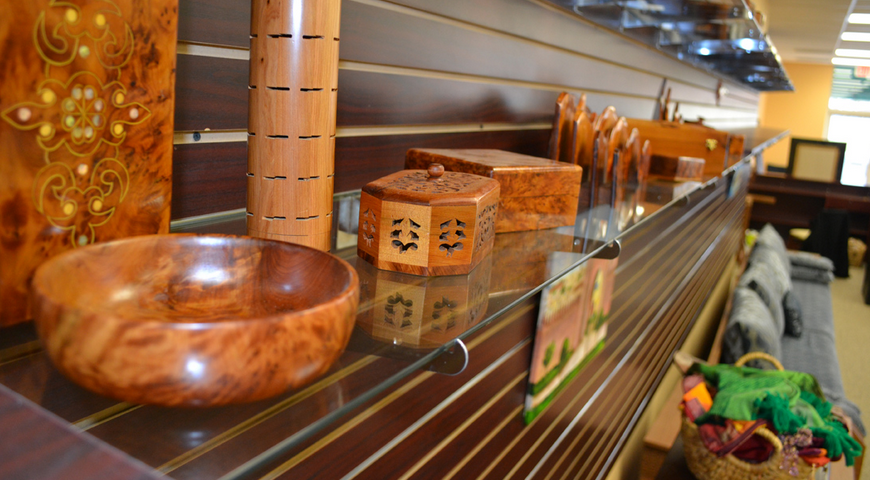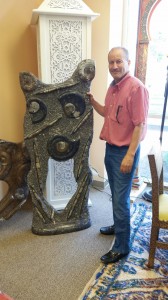Updated
First US-based Moroccan Design Showroom Opens – Jean R. AbiNader
Features Stunning Moroccan Handicrafts, Fashion, and Furnishings
Jean R. AbiNader, MATIC
August 17, 2015
In late spring, Fatema Marouane, Moroccan Minister of Handicrafts, Social Economy, and Solidarity, presided at the official opening of Morocco Premier Events (MPE), the first totally Moroccan design center in the US. While other design stores may feature a few handicrafts from Morocco or look-alikes from India, MPE is the real deal. Located in the Dulles Design Center in Sterling, VA, it is the brainchild of Hassan Samrhouni, the latest venture for this Moroccan-American entrepreneur who has been a force in community events for 25 years in the Washington, DC area.
The showroom is expansive, featuring a large central area with furnishings, crafts, design elements, sculptures incorporating age-old fossils, lamps of many types, cosmetics, rugs, and brass and nickel objects. There are separate sections featuring caftans, jewelry, and an impressive library. The common thread to all the items is that they are handmade– nothing is mass produced, supporting hundreds of artisan families in all parts of Morocco.
As you walk through the front entrance, you are greeted by fossils embedded in standing sculptures, modern designs featuring remnants of sea-life that existed in Erfoud—an oasis town in eastern Morocco– centuries ago. According to wiki voyage, “Erfoud is known for its precious and unique fossils. Back 500 million years ago, the Sahara Desert was under water. On the outskirts of Erfoud you can visit impressive fossil filled marble workshops and other type of fossil varieties such as trilobites and ammonites.”
There is a large collection of rugs, courtesy of Jouti Rugs, a store in Marrakech that boasts the largest collection of rugs and kilims from the Atlas Mountains and the Moroccan Sahara. More than 200 examples of their collection are available at MPE. The suppliers for the showroom were especially chosen by the Ministry to demonstrate the excellence of Moroccan artisanal crafts. There are several monitors in the showroom featuring videos prepared by the Ministry to highlight the artistry and workmanship behind the products on view.
Other partners of MPE include the Maison de l’Artisan, www.maisonartisan.ma, a key player in Morocco’s national plan, Vision 2015, to support and encourage local artisans. Included in the displays are brass lamps of imaginative and traditional design; wood boxes and design elements made from thuja, an aromatic evergreen from the Atlas Mountains; and a wide variety of candles, poofs, furniture finished with brass details, painted wood tables, mosaic tables, pillows, and even a television console covered in hammered brass.
To delight the senses even further, there are silver urns, coffee and tea pots and service sets, a fountain waiting for someone’s garden or salon, and caftans of marvelous colors and patterns. Of particular interest are four caftans made in the 1950s on loan to the MPE from a private collection: a man’s three-piece ensemble tailored in Libya, a caftan from Alexandria, Egypt, a caftan featuring Jewish embroidery designs from Constantine in Algeria, and a classic Moroccan caftan.
There is also a unique story behind the Casablanca Secrets brand cosmetics: created by three Moroccan professional women with university jobs in medicine and the sciences who decided that there should be a full line of locally produced items. These are now being distributed throughout the US by MPE, including: skin cleaners and moisturizers, aromatic candles, lava clay facial scrubs, and massage oils.
Building Cultural Awareness and Building a Business
This has not been an easy quest. Design consultants and designers who would most appreciate the value of MPE’s showroom and supplier relations are difficult to access if you are not a member of a design center. Mr. Samrhouni has recruited Linda Kay Myers-Figley as his director of marketing, and she has contacts throughout the region in the design community, yet, it is still tough going.
For example, getting products certified for sale in the US requires meeting regulations for each item. It took 18 months of work for Casablanca Secrets to meet US certification requirements. The wondrous Moroccan lamps can’t be sold until they are UL certified, which means that anything that has come from Morocco has to be re-wired and inspected before it can be shipped.
So there is an educational process going on, Americans learning about the value of one-of-a-kind artisanal products that are not bargain-priced; and Moroccans learning about labeling and certification standards that are part of doing business in the US.
In the meantime, MPE continues its outreach. School groups visit, getting to experience Morocco without leaving home. Arab radio broadcasts have been aired there. A French class from a local university had a session in the showroom. It is, as Linda Kay points out, a cultural center, a place to share about Morocco, its hospitality, and its vibrant society. And to round out its offerings, MPE provides a full line of special events services including catering, design environments, music, and programming.
As MPE grows, it will expand its capability to provide custom-made furniture, rugs, wood objects, and other products to meet specific designer needs. There is still a lot of learning going on regarding shipping, customs, finding reliable distributors, and linking up with even more suppliers in Morocco who have the ability to meet the quality and quantity criteria of MPE. It is an important milestone in continuing to join these oldest of allies together through the expression of Moroccan culture by its best ambassadors – its artisans.


